The Nexus 7 (2013) Review
by Anand Lal Shimpi on August 22, 2013 6:00 PM EST
Truth be told, Google has made (or at least directed the making of) some of the best tablets on the market today. The original Nexus 7 was groundbreaking in that it offered a totally usable platform, married to the latest version of Android, for $199. The Nexus 10 gave us a very quick, ultra high resolution 10-inch tablet for $100 less than the flagship iPad (and with more storage). Both were easily recommendable due to their value, but this year Google is stepping out of the shadow of value and into one of excellence. It starts with the new Nexus 7.
Based on the success of the original Nexus 7, Google went back to ASUS for the second version. In the 12 months since the release of the Nexus 7, the world has changed quite a bit. Expectations for value tablets had been reset by the original Nexus 7 as well as Amazon's lineup of Kindle Fires. Simply showing up with another good value likely wouldn't do anything to further the brand (or market). I get the distinct impression that Google isn't big on not changing the world.
| Nexus 7 Tablet Specification Comparison | ||||
| ASUS Nexus 7 (2012) | ASUS Nexus 7 (2013) | |||
| Dimensions | 198.5 x 120 x 10.45mm | 200 x 114 x 8.65mm | ||
| Chassis | Plastic + Rubber back | Plastic + Soft Touch back | ||
| Display | 7-inch 1280x800 IPS | 7.02-inch 1920x1200 IPS | ||
| Weight | 340 g | 290 grams (WiFi), 299 grams (LTE) | ||
| Processor | 1.3 GHz NVIDIA Tegra 3 (T30L - 4 x Cortex A9) | 1.5 GHz Qualcomm Snapdragon S4 Pro (APQ8064-1AA) | ||
| Memory | 1 GB | 2 GB DDR3L | ||
| Storage | 8 GB / 16 GB | 16 GB / 32 GB | ||
| Battery | 16 Whr | 15.01 Whr | ||
| WiFi/Connectivity | 802.11b/g/n, BT, NFC | 802.11a/b/g/n, BT 4.0, NFC | ||
| Camera | 1.2MP Front Facing |
5.0 MP Rear Facing w/AF 1.2MP Front Facing |
||
| Wireless Charging | – | Yes (Qi Compatible) | ||
| Pricing | $199/$249 |
$229/$269 (WiFi 16/32 GB) $349 (LTE) |
||
The result is the new Nexus 7. Identical only in name, manufacturer and screen size, the 2013 Nexus 7 is a downright Apple way to rev a product. Google made it thinner, lighter, faster and better in almost every way.

2013 Nexus 7 (left) vs. 2012 Nexus 7 (right)
The original Nexus 7 was rather thick but it got away with it since the overall footprint of the tablet was so small. The new Nexus 7 truly feels like a slate. It's the type of thing I expect to see carried around on the Enterprise.
I don't miss the rubber imitation leather from the original Nexus 7, it's replaced by a soft touch plastic back. You definitely don't get the premium aluminum feel of the iPad mini, but the device doesn't feel cheap either. The new Nexus 7 is still nice enough that I'm nervous about scratching or scuffing the back.
Both ASUS and Nexus logos are prominently featured on the back. ASUS continues to amaze me by just how far it's come as a company, and the new Nexus 7 is hands down its most impressive tablet creation yet. From a build quality standpoint I really have no complaints about the Nexus 7. While the MeMO Pad HD7 has some creaks and flex in the chassis, the new Nexus 7 feels like a solid slab of soft plastic and glass. It's nice.
Unlike the original Nexus 7, the new model features stereo speakers on back of the tablet. It's an easy feature to take for granted but going back to the old mono design sounds worse.
I agree with Brian that the power/lock and volume buttons are the only real sore spot on the physical execution. They aren't particularly well defined and feel a bit mushy. Even writing this paragraph feels like I'm nit picking though, the build here is really good.
The only other complaint I'd levy against the new Nexus 7 is that the design doesn't particularly stand out as being unique. The iPad has its aluminum, the Moto X has its wood, but the Nexus 7 falls victim to the fact that ultimately it's tough to make these ultra mobile devices stand out. You need a large glass surface and you need a back. Black also tends to be one of the easier colors to sell (get too creative and you end up with inventory problems). It's not a huge deal to me personally, but as mobile devices can often be fashion statements I don't know that the new Nexus 7 has all that much curb appeal.
The Display
What the Nexus 7 lacks in pizazz, it completely makes up for once you power on the display. The 7-inch 1920 x 1200 display produces colors that are not only vibrant but, for the first time ever in a Nexus device, accurate as well. Google really worked on color accuracy this time, with a two step calibration process - once at a high level by the panel maker and once again per device during final manufacturing. The result is just awesome:
The Nexus 7 display is not only visually appealing but stacks up incredibly well in our CalMAN display tests. Although it loses to the iPad 4, the Nexus 7 gets indiscernibly close in many cases and blows the non-Retina iPad mini out of the water. I won't even bother comparing it to everything else in the Android space, they don't hold a candle to it.
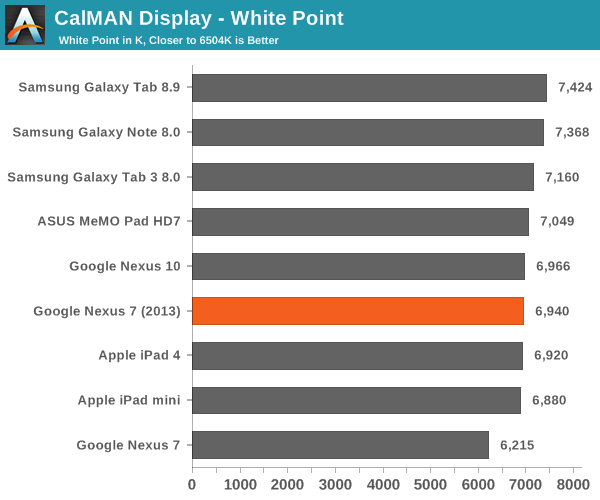
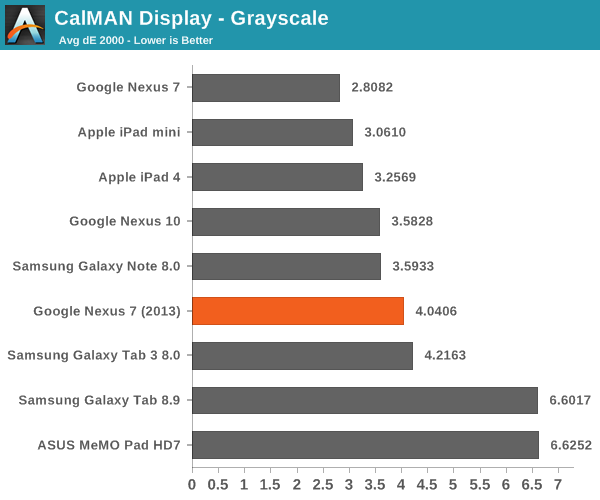
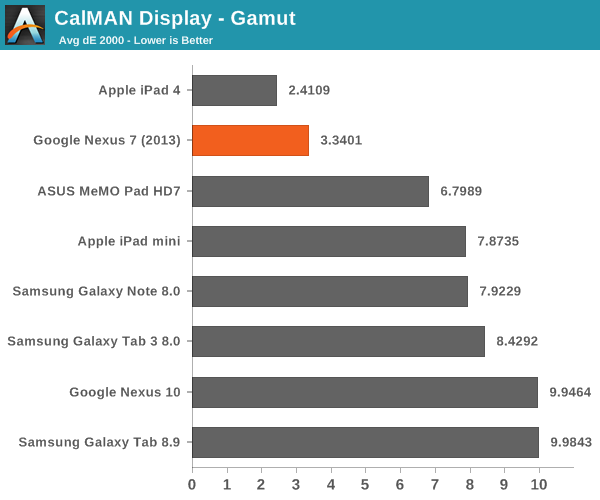
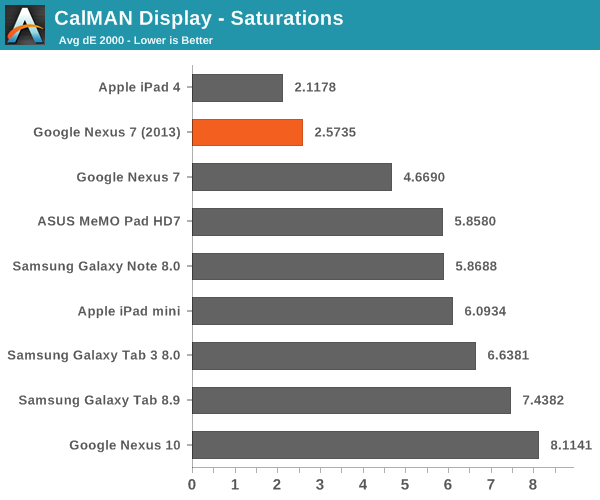
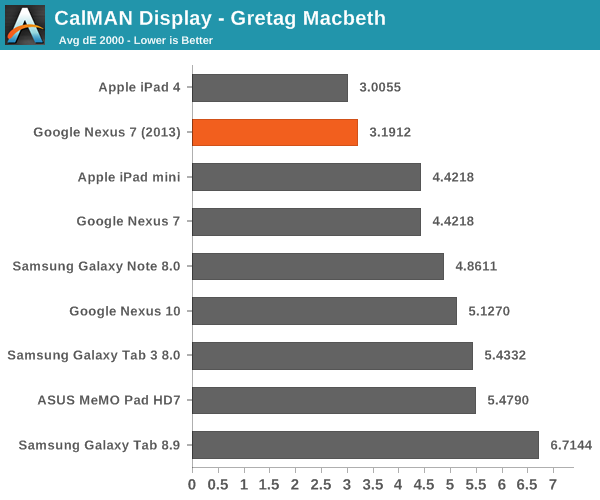
The new panel is also incredibly bright. I typically view 500 nits as the threshold for outdoor usability, and the new Nexus 7 definitely exceeds that threshold. The tablet will drink away all of your battery life if you leave it at this brightness setting indefinitely, but if you need to actually use your tablet outdoors for a while the Nexus 7 works.

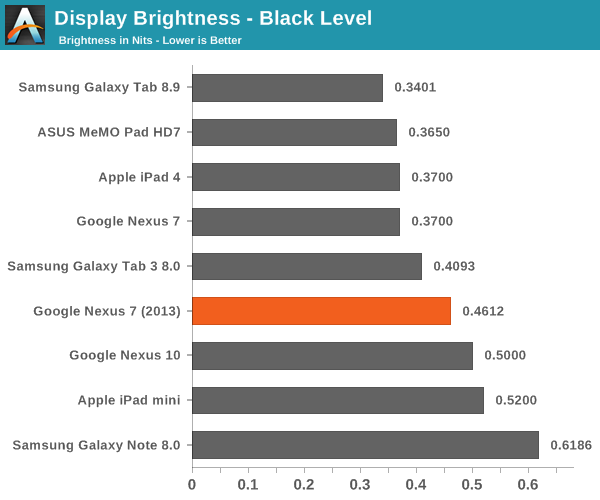
Black levels are a bit higher than on the original Nexus 7, but the resulting peak contrast ratio is still excellent:
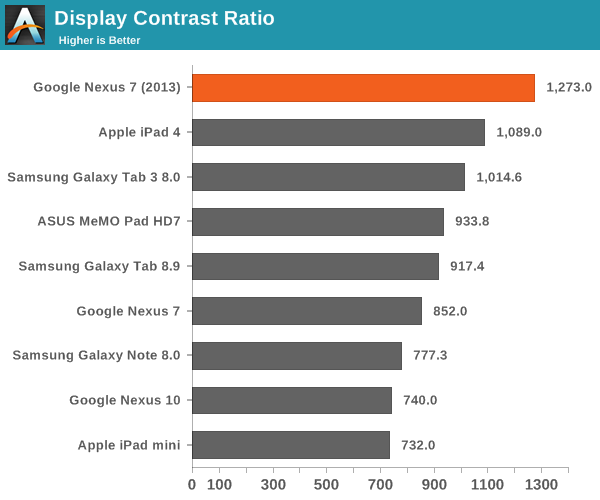
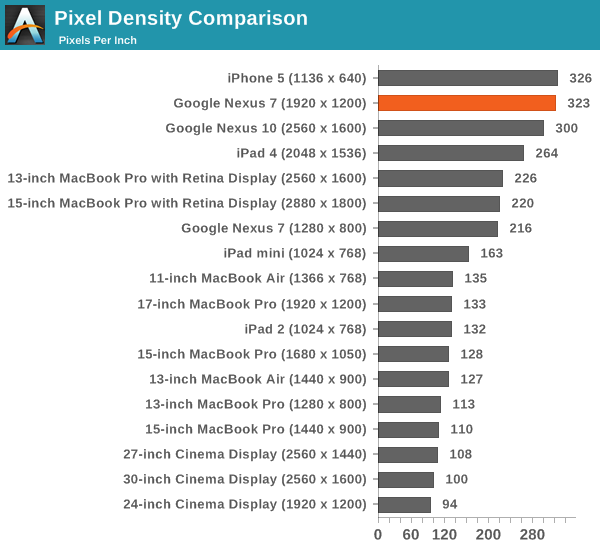
Pixel density shoots through the roof with the new Nexus 7 display as well. Brian was quick to point out that a major advantage of the Android platform is in its flexible resolution handling. The 1920 x 1200 panel presents itself as a 960 x 600 panel to web pages in Chrome, while other apps can use every last pixel for unique content (e.g. games).
The beauty of not having to double the original Nexus 7's resolution but instead settling on an in-between option like 1920 x 1200 is that Google could get away with a performance mainstream SoC instead of something ridiculously high-end.
The display looks great when viewing everything from photos and movies to web pages and eBooks. My only complaint about the Nexus 7's display is its size. A 7-inch tablet is almost pocketable (in fact I did carry it around in my pocket for a day), but the screen can feel a little cramped.


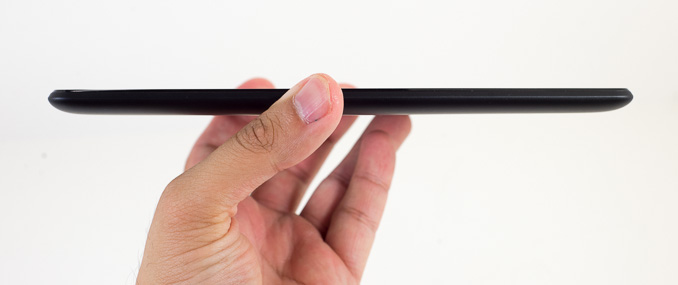
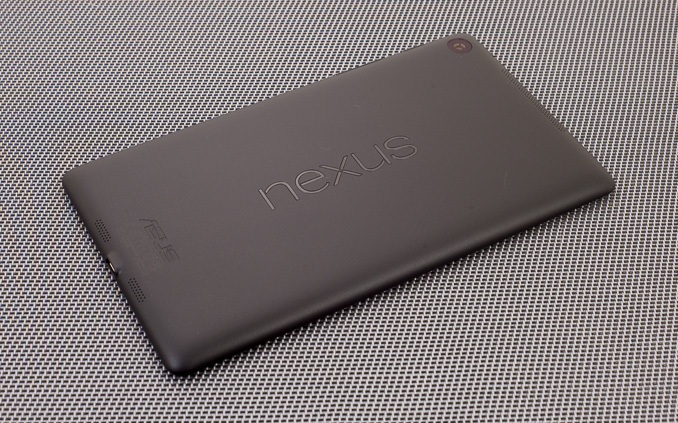
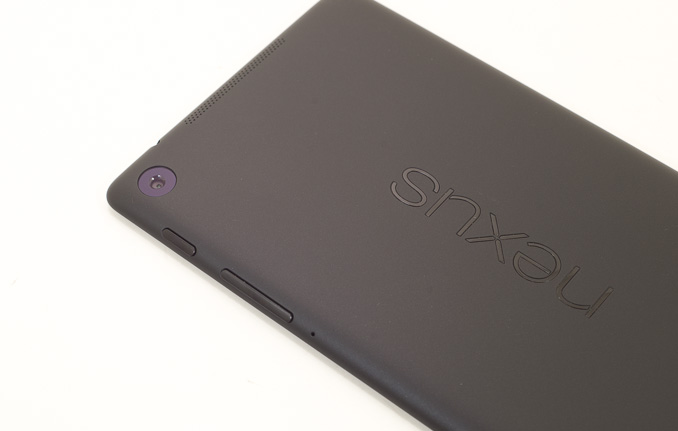


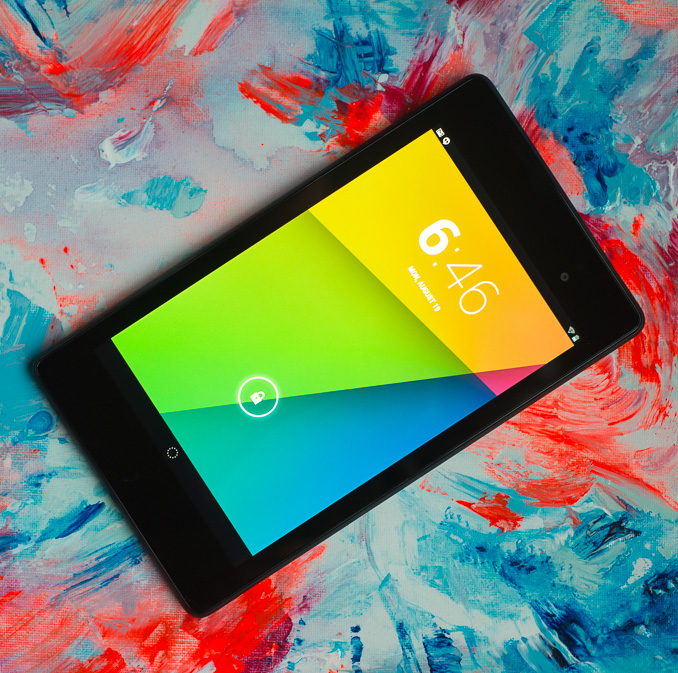
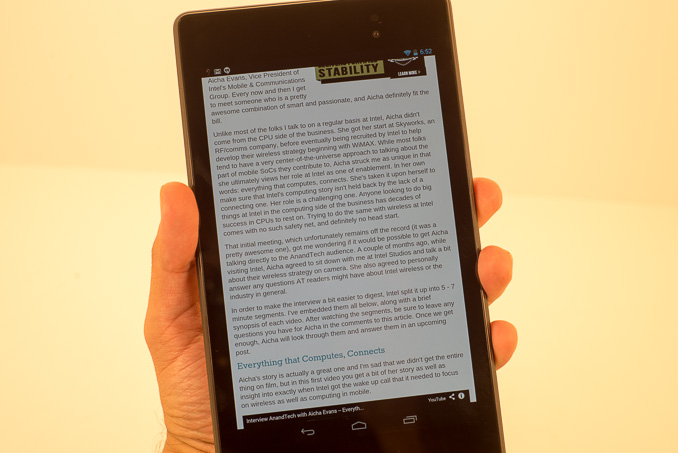
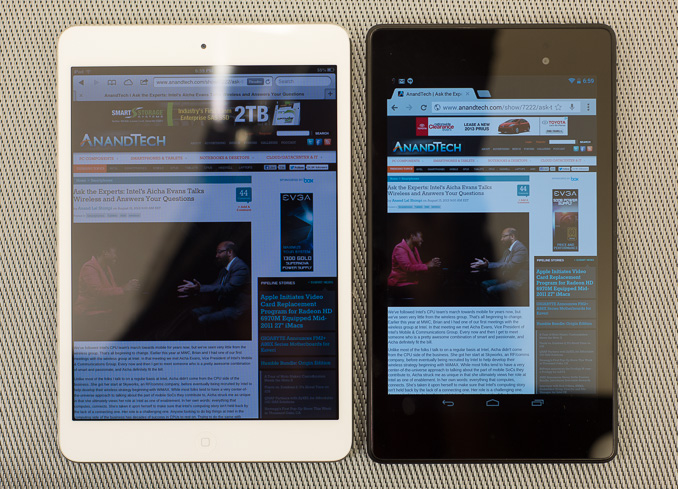








202 Comments
View All Comments
iampivot - Saturday, August 24, 2013 - link
Is the GSM modem on the 4G / LTE version locked down, so that you cannot make calls nor send SMS messages, like the original nexus 7?Shukla - Saturday, August 24, 2013 - link
Is it me or is this about 1 year behind iPad? So google puts out an iPad 4 competitor 1 year later??I'm no apple junkie but why is it that each year apple resets the bar and everyone spends the year catching up but not passing in everyway?
1. No individual app privacy controls
2. Longer battery life than iPad/iPhone (by wide margin).
I need a job with google marketing- they suck.
GTBandit22 - Saturday, August 24, 2013 - link
Well considering this is a 7 inch tablet, and half the cost of the entry level iPad, I would say you're making a bad comparison.I would say that Apple is behind in the small form factor race. 6 months behind.
akdj - Sunday, August 25, 2013 - link
Possibly because the released (Apple) their tablet nine months ago? It'll never end. They're working six months apart. With each company's current release, it'll 'best' the six month old competitors. Technology, especially low power SOC and GPU designs are developing at a rapid pace. Give it a couple months and we'll see the same thing happen with Apple's new lineup. In fact, the iPad 4 is still holding up...as is the iPhone 5 to the current crop of Android releases (other than extreme screen sizes). I like what Google is now doing with their Nexus series. Like Apple, they're designing (or helping design) the hardware and optimizing their software to work efficiently together. Super smart decision without the carrier and OEM skins we've had to live with until these new Nexus tablets have released. Smart. Idea.lightsout565 - Sunday, August 25, 2013 - link
Can someone provide me a link with a more detailed outline of how the WiFi web browsing test is conducted? Thanks!mikeyfouc - Monday, August 26, 2013 - link
Can this plug into a VGA overhead projector to mirror the screen? I'd really like to get a tablet that allows me to show Powerpoint presentations on a VGA projector. I've seen AT's review of SlimPort, but it only has a video of the mirroring on a widescreen HD TV via HDMI. Also, I've searched all over the web: can Android show powerpoint presentations in slideshow mode (as you'd see on a PC)?Shopov - Tuesday, August 27, 2013 - link
Excelent review! My question-Nexus 7 (2012) does not support WiFi Ad Hoc (ibss). This is boring since its only WiFi version (no LTE) cannot receive WiFi from tethered smartphone (mine is Nokia C-7). What about the WiFi of the new Nexus 2013? If the answer is positive this would be a big advantage. I should mention that several Android 4 tablets receive WiFi Ad Hoc (ibss).Nexus 7 2013 - Thursday, August 29, 2013 - link
For anyone considering this device, please check out the forum on Google :https://productforums.google.com/forum/#!topic/mob...
Majority are as reviewed, but a small, yet growing number are effected by software/hardware issues that, after a month's time, are yet to be concretely dealt with.
Buy only from a vendor having a good solid return/exchange /refund policy.
Hrel - Thursday, August 29, 2013 - link
No 802.11ac?! Lame."The beauty of not having to double the original Nexus 7's resolution but instead settling on an in-between option like 1920 x 1200 is that Google could get away with a performance mainstream SoC instead of something ridiculously high-end."' ... what? That's a ridiculously high resolution, Apple is stupid for thinking a resolution that high is useful.
I'd like to see them go 16:9, make the device 8" and give it a 1920x1080 display resolution. Perhaps next year, with 802.11ac.
With that said, I can't see myself even entertaining the idea of actually buying a tablet unless it's gaming focused like the Nvidia... thingy...I forget the name.
This is how I see it, tablets are secondary for web browsing in the first place, anyone in their right mind prefers using a laptop. Which, let's face it, anyone who can afford a tablet already has. So, WHY would someone buy a device where the primary focus is web browsing? Give me a tablet that's focused on mobile gaming (PSP/gameboy style) that also has all the functionality of one of these tablets, web browsing. I think Nvidia is on the right track, streaming desktop games so you can lie in bed and play without having a laptop on your chest and your wrists angled awkwardly. Play mobile games when away from home/on a plane/cab. Also allows you to read ebooks and listen to audio books AND check facebook/reddit/anandtech/twitter whatever, newegg and amazon and such.
I think if Nvidia just keeps doing what they're doing they're next gen "tablet" could be the perfect device. The only recommendation I'd make is to choose to focus on making it as good a mobile reader as an IPS display can be, it won't ever be as good as a kindle with that Eink display, but if it's close enough, and they can produce numbers to show no meaningful eye strain then I'm sold. They've gotta compete with Razer Edge, or whatever, too.
justacousin - Tuesday, September 3, 2013 - link
So what is going to be Nexus devices in improving their device?